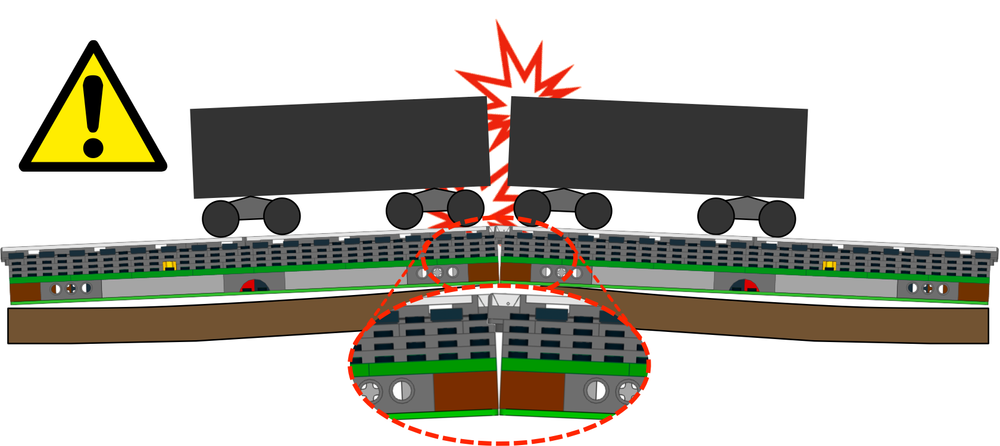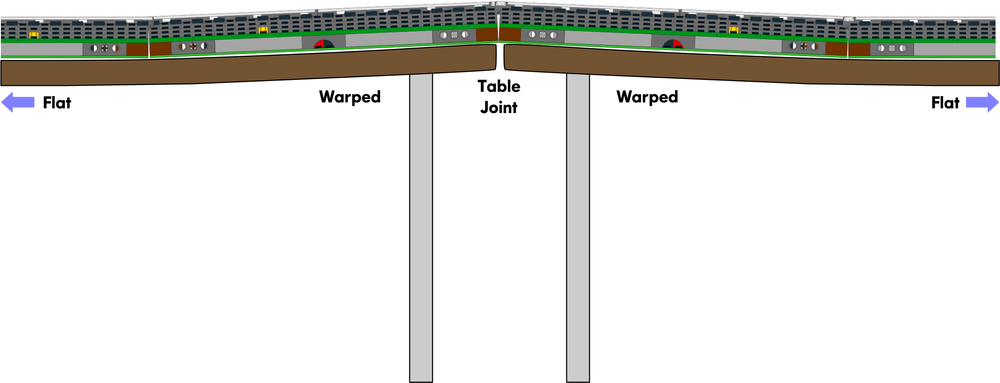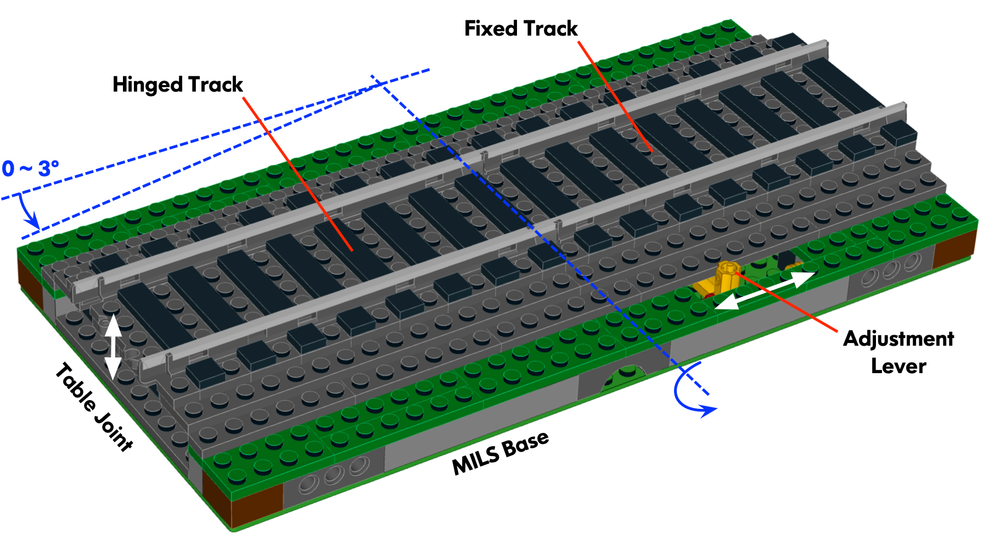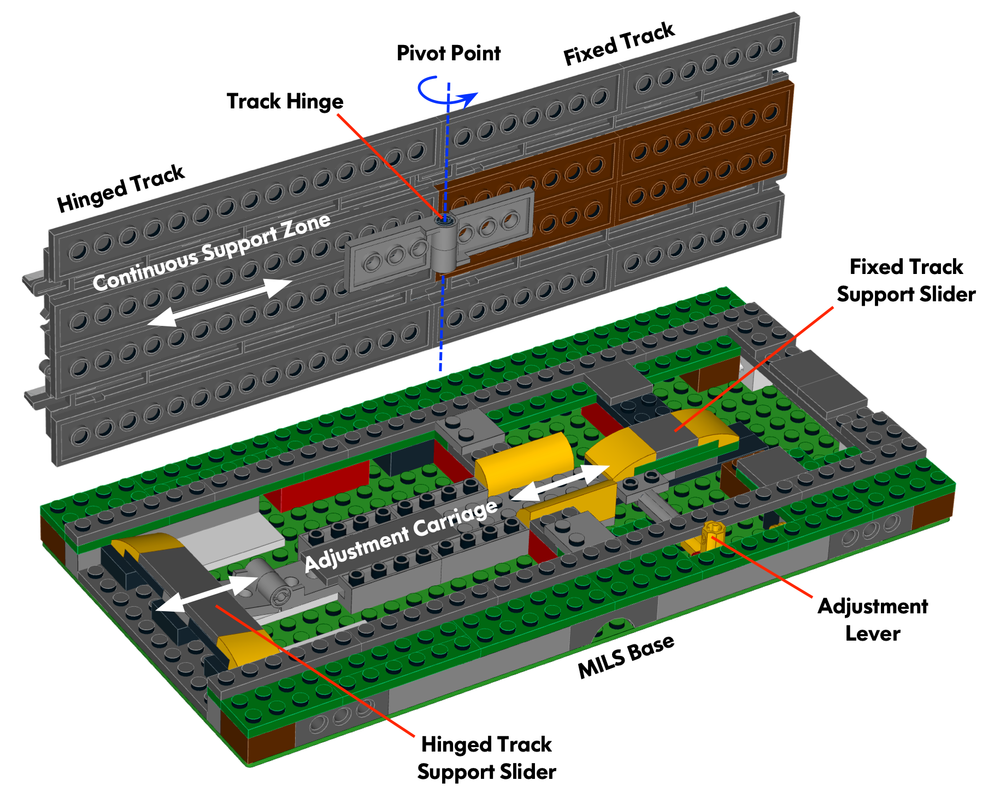Crooked Tables: A Hinged Fix for Better Running Trains
A few months ago, I exhibited a sizeable LEGO train layout built entirely from MILS modules placed on venue-provided tables. No doubt, the phrase “venue-provided tables” will already conjure up a range of uncomfortable memories for those of you familiar with setting up large LEGO creations (not just train layouts) that span one or more tables!

Venue tables range in both quality and vintage, from elderly specimens made from de-laminating warped plywood to more modern sagging injection molded plastic. No matter their provenance, we can always assume that these tables will neither be flat nor consistent! And nowhere is this phenomenon more apparent than at the joint between adjacent tables.
I am sure many of you are familiar with the trial-and-error process of endlessly shimming the legs of tables not only to achieve flatness but also to correct the inevitable difference in vertical height between adjacent tables.
The Joint Problem
The use of MILS modules does help to some extent. Their rigid structure and mutual connections does tend to smooth out modest height and gradient variation. However, there are circumstances where warped tables and joints between modules cannot be corrected easily.

Two MILS Train track modules meeting a straight and level joint — our goal for every module connection

When Two track modules meet a warped table joint, our straight and smooth trackbed becomes an accident waiting to happen!
For train layouts, the distorting effects of warped tables can have a severe impact on the quality and reliability of running trains. This includes:
Excessive Gradient Load - Locomotives struggle with excess load on positive gradients, causing speed variations and increased battery consumption.
Excess Wear and Tear - Items such as wheels, bogie pivots, couplers, and even the locomotive/wagon structure itself will be subject to excessive wear and tear due to the repeated effects of sudden shifts in vertical displacement. This corresponds to impact and shear forces on these items, which will lead to abrasive wear and, in extreme cases, failure of LEGO clutch connections.
Coupler Separation - Repeated vertical shifts across a crooked rail joint can cause some magnetic couplings to separate, resulting in unexpected split trains and eventual collision of the locomotive with the back of its own train!
Derailment - In extreme cases of crooked rail joints, complete derailment is always a possibility and can lead to frustrating operating sessions—especially at public events.
Shown below is a representative diagram of the most common and frustrating scenario I often encounter:

More often than not, the table is relatively flat except at the corners where warping and distortion seem to be more concentrated. Even with MILS modules, it is almost impossible to correct the severe vertical deflection when attempting to span the table joint.
If we examine this joint closer and consider its impact on running trains, we can see that the track bed is sharply separated by a sudden change of gradient.

As trains pass over this joint, its wheels endure higher impact loads crossing the joint, bogie pin pivots endure impact shear forces from the sudden change in angle, and finally, couplers are also forced to react to sudden vertical displacement and could momentarily separate depending on train speed and load.
When I was confronted with just the same scenario shown above, which no amount of shimming could correct—I wondered if there was another way of improving the situation. I think it is safe to assume that all tables will exhibit some form of distortion and variability. Therefore, rather than correct the tables themselves, let’s give our track modules the ability and resilience to adapt to inevitable table variations.
A New Type of MILS Module
When I looked at the contour of the track bed across the joint—I could imagine a track contour that did not follow the shape of the MILS module it was mounted to—but instead passed right through the joint by diving down below the nominal trackbed height across the joint and softening the resulting track contour. This is shown in the diagram below:

It might not be immediately obvious in the diagram, but the two track segments which span the table joint actually tilt down (relative to the MILS module) and meet at a straight and level joint with little to no vertical displacement. The overall track contour is much smoother by spreading the required vertical variation across 3x rail joints rather than one.
After building a hasty prototype on site—that is ripping apart a few MILS module and improvising some changes—I more or less had a proof-of-concept! This involved removing the support structure under the track and replacing by a couple of bricks and plates to let the track “droop” to a new contour.
I have now formalized this concept into a new general purpose MILS track module shown below:

MILS Single track BTM module with adjustable track gradient.
This new MILS track module incorporates the following features:
Hinged track section (16 studs) with up to 3º of gradient adjustment.
Variable gradient selection with a simple and discreet operation lever.
Gradient can be locked at 0º and be used as a standard track module.
The diagram below shows the mechanism under the track which performs the adjustable gradient:

The track module consists of two 16-stud track segments: one is fixed in place and the other is hinged. The hinged track is supported by a sliding adjustment carriage which supports the track segment at a variable height depending on its position. Furthermore, the fixed track segment is always supported at a fixed height in all positions.
A lever protrudes just above “ground level” next to the fixed track and is used to adjust the gradient. When a desired gradient is selected, the lever can be locked in place simply by confining its movement with two plates on either side. The range of gradient adjustment is shown below for a few representative positions:

Instructions to Build the MILS Hinge Module

This new MILS module might not be the best way of achieving variable gradient adjustment nor the best solution to the overall problem of warped tables. However, it does offer a dramatic improvement in running performance compared to no adjustment at all. I am sure some Technic “gurus” can probably refine this mechanism even more and I am keen to see other improvements and implementations to achieve the same goal.
Instructions for this new module can be downloaded from l-gauge.org.
We must accept that tables will almost always be crooked to some extent. Thus, our best strategy is preparation with better tools in our layout building toolbox to minimize their impact.
What do you do to level tables for large LEGO displays? Let us know in the comments below.
Do you want to help BrickNerd continue publishing articles like this one? Become a top patron like Marc & Liz Puleo, Paige Mueller, Rob Klingberg from Brickstuff, John & Joshua Hanlon from Beyond the Brick, Megan Lum, Andy Price, Lukas Kurth from StoneWars, Wayne Tyler, LeAnna Taylor, Monica Innis, Dan Church, Roxanne Baxter, and Steven Laughlin to show your support, get early access, exclusive swag and more.
